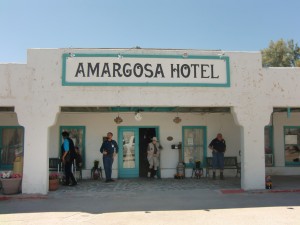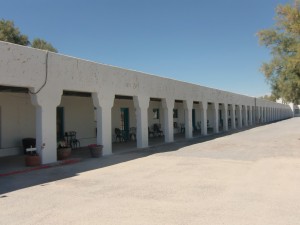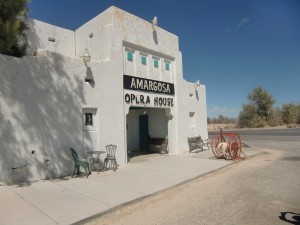A FEW DAYS IN DEATH VALLEY – DEATH VALLEY JUNCTION
A FEW DAYS IN DEATH VALLEY
DEATH VALLEY JUNCTION
By Charles N. Stevens
Photos by Dolores Seidman
We leave on a tour bus from Montclair on a clear spring morning, bound for Death Valley. The bus is soon rolling along Interstate 210 and then Interstate 15 which will take us out to the desert. It’s great to be traveling through Cajon Pass again with mountains on both sides. We’re out of the city and into nature again. Being up high in a tour bus gives us much better views than we would have from our car. Cajon Pass is the only pass between the San Gabriel and San Bernardino Mountains, and was formed, lucky for us, by the famous San Andreas Fault. In 1851, Mormon settlers traveling from Salt Lake City to southern California in covered wagons discovered the pass. In the 1880s the first railroad tracks were laid through the pass. Now, both the Union Pacific and the Burlington Northern Santa Fe railroads use it. Being a railroad buff, I enjoy watching the long freight trains winding through the canyon. Over 150 trains a day pass through it. I can see one now slipping slowly around a great curve, its yellow locomotives at full power, grinding up the steep grade.
About halfway up the canyon, near where Highway 138 branches off, are the Mormon Rocks. Huge rounded and tilted sandstone forms that appear to have been pushed out of the earth. And in a way they have, thanks again to action along the San Andreas Fault. I look at them on our left as we approach. They stand out not only because of their hugeness, but also because they differ so much from the land around them. Years of wind and rain have smoothed them, making them look more like great Henry Moore sculptures than rocks. As we pass them, I can see smooth holes in their surface. The Mormon Rocks derive their name from the passage of Mormon settlers as mentioned above.
We finally reach the Cajon Summit at close to 4,000 feet and begin a slight descent into the Mojave Desert. The scene having dramatically changed now, we look out on acres of Joshua trees, spreading out for as far as we can see. Their thick branches seem to suggest men reaching for the sky. The Mormons saw Joshua with his arms raised to the heavens, thus naming the tree. As we continue dropping in altitude, the Joshua Trees begin to thin out and are replaced by the olive-green of the hardy creosote bush, the dominant shrub of the desert.
Our bus zips through the rapidly growing city of Victorville, much of its expansion along Interstate 15 where there are many new malls featuring all the stores and fast food restaurants that we are familiar with. We leave Victorville as we cross the dry Mojave River with its forest of cottonwood trees and head for Barstow. Having lived and taught school in Barstow for several years a very long time ago, I am always interested in any changes. The city is a major junction of the Burlington Northern Santa Fe Railroad, their freight yards now vastly expanded. During the summers I lived in Barstow, I worked in the old railroad yards. Barstow is also the junction of Interstate Highways 15 and 40 and the home of the huge Marine Supply Depot and the Army’s Camp Irwin. .
The “painted” Calico Mountains are on our left as we leave Barstow and head through many miles of stark desert for Baker. The most distinctive attraction in Baker is their 134 foot thermometer displayed prominently at its west end. I look at it as we pass, seeing if it is actually working as it often breaks down. Baker acts as a halfway point between Los Angeles and Las Vegas, so it is crowded with gas stations, motels and restaurants. Baker was once a station on the now defunct Tonopah and Tidewater Railroad and derived its name from the railroad’s president, Richard C. Baker. It’s a hot place, the maximum temperature in July averaging 110 degrees. The record high is 124 degrees. Our bus noses through the congestion of the town and lets us off for lunch at an attractive new service area.
We leave Baker and Interstate 15 as we turn north on Highway 127, the road that will take us to Death Valley Junction. When we arrive there, we stop in front of a long, row-like, white structure, the Amargosa Hotel and Opera House. We leave the bus, feeling the midday heat, and walk toward the lobby of the blinding white hotel. It consists of only 15 rooms, most of which are booked far in advance. We walk the halls, occasionally stopping to view paintings. The hotel seems nicer inside than outside where the paint is beginning to peel. The adobe structure was built in 1925 by the Pacific Coast Borax Company to house its workers.
Even more interesting is the Amargosa Opera House situated at one end of the hotel. It had originally been a community room until the 60s when Marta Becket, a dancer and actress from the east, “discovered” it. She made it into her own theater, constructing stage sets and performing dance and mime shows that were well attended. An audience of sorts was beautifully painted inside as murals on its adobe walls. She retired in 2012 and died this year at the age of 92. Both the hotel and the opera house are on the National Register of Historic Places.
Soon we’ll be off to Death Valley.

The adobe Amargosa Hotel has only 15 rooms and is on The National Register of Historic Places.

The long white hotel was originally built for the workers of the Pacific Coast Borax Company.

The Amargosa Opera House was made famous by the dancer and actress Marta Becket.

Murals painted on the interior walls of the opera house provide an audience of sorts.
MONTEREY PARK AUTHOR PUBLISHES 4th BOOK – Seeking More of the Sky: Growing Up in the 1930’s:
Charles “Norm” Stevens, a 43 year resident of Monterey Park has recently published his 4th book: Seeking More of the Sky: Growing Up in the 1930’s. This is the story of a young boy growing up in Inglewood, California in the l930’s. This was a time during the depression when unemployment was affecting many and the banks were closed, while the clouds of war were gathering in Europe. But he was lucky enough to be raised in a loving family, the power of that love reflected throughout his stories.
Stevens is the author of three previous books about his experiences during WWII:
An Innocent at Polebrook: A Memoir of an 8th Air Force Bombardier (Story of his 34 bombing missions from his base at Polebrook, England over Germany and France)
The Innocent Cadet: Becoming A World War II Bombardier (A prequel to the first, telling of his training in the U.S. before going overseas into combat.)
Back from Combat: A WWII Bombardier Faces His Military Future from Combat: (This book details the time from when he returned from combat in England until the end of the war.)
He is known to the readers of The Citizen’s Voice as the author of Travel Log Articles including “Cruising the Rhine and Mosel”,” Best of the West”, “In Search of Snow” , “From Paris to Normandy on the Seine”, and “Exploring New York”. He is retired, having taught for 32 years, primarily in the Montebello Unified School District.
Those interested in purchasing an autographed copy of any of his books, may contact the author at 323-721-8230 or Normstevens24@gmail.com.



